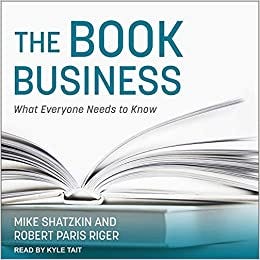Four Questions with Supply Chain Expert Mike Shatzkin
We talk about Ingram, the book printing and distribution company behind almost every book you read
If you’re like me, the headlines promising a shortage of physical books later this year filled you with dread. Books are my go-to holiday gift — I love picking out the right title for the right person — and there’s a number of 2021 releases that I’m hoping to either purchase or get from the library.
Most articles about the book shortage point to booming demand for books (paper book sales in the first half of 2021 are up 18.5% compared to the same period in 2020) and a shortage of paper and labor as causes.
To understand if I really needed to panic, I reached out to Mike Shatzkin, a book supply chain expert and co-author of The Book Business: What Everyone Needs to Know, who helped me see that the supply chain issues the publishing industry is facing extend beyond surging demand and a shortage of materials. Instead, they reflect changes in how books are printed and distributed.
Our conversation has been edited and condensed for clarity. This is longer than most of my Q&As, but it’s a complex issue — and one I think readers should pay attention to. The moral I took from our chat is that if there’s a title coming out this fall or winter that you really want, order it now (and preferably from your favorite independent bookstore).
From your perspective, what’s driving the publishing supply chain issues?
There aren’t as many printers as there used to be because we’ve changed how books are printed.
Up until very recently, books were printed in press runs of 3,000 to 5,000 books. Then came along print-on-demand from Ingram* (a wholesaler and distributor). With Lightening Print, Ingram said, ‘For a straight textbook, we can print one copy at a time. If you order a book today, we’ll print it for you tonight and ship it to you tomorrow.’ It’s the same book and most people wouldn’t discern any quality difference between a print-on-demand book and a traditionally printed book.
Publishers benefited from this model because they no longer had to commit to large, expensive print runs. So, over time, more publishers moved to a print-on-demand model, which meant a reduction in demand for printing. In turn, traditional printers, expecting less need for their services, slowed their investment in printing presses. Printers are now going out of business and the ones that do exist aren’t printing as many books as before.
It used to be that a publisher could place an order for thousands of books and get them reliably in six weeks. Now it can easily be 14 weeks because all of the traditional presses are tied up since there just aren’t as many of them. As publishers saw that traditional printing was getting unreliable, they shifted even more to Ingram print-on-demand, especially at the beginning of the pandemic to keep up with the surging demand. So, the cycle repeats.
The combination of factors has created unreliability in the printing supply chain. All of this makes e-books that much more important, because they're infinitely replicable and instantly deliverable, regardless of the circumstances.
Want to receive Q&As like this one — plus weekly book recommendations — in your inbox? Subscribe to What To Read If.
So, when I order a book from bookstore, the store orders it from Ingram?
Ingram is a book distributor and a book printer so they might already have it on hand, or they might print it. Right now, everyone in the book business globally buys their physical books from Ingram.
Ingram is a wholesaler to bookstores. When I first came into this business in the 1960s and 1970s, bookstores ordered directly from publishers. There were 40 or 50 significant publishers, it was before all of the consolidation we have now, and every bookstore had to do business with each of them. This model made it hard to place an order for very few books from a publisher.
Ingram, as a wholesaler, started to stand between booksellers and publishers. It meant that bookstores could more easily order books from a variety of publishers. And in the 1970s, Ingram pioneered the use of a microfiche reader to print their entire inventory. It meant for the first time stores could see the 50,000 to 75,000 books available from the wholesaler. They mailed the catalog weekly, and suddenly the stores only ordered what Ingram did have, not what they didn’t have. Fill rates, the fraction of orders that can be met immediately, jumped from the low teens to 99%. Ingram started carrying more and more books.
In today’s world, this is much easier technically — giving someone information about the database of books you have — but it changed the business. Ingram became the place to go to order books.
Ingram has revolutionized the book business, I would say, more than any other single company has revolutionized anything — with the possible exceptions of Apple and Microsoft.
How do you see the current supply chain issues shaking out?
It’s going to be a while before we know exactly what the new normal is, but I think it will include a lot more print-on-demand in 2025 than there was in 2005.
And there are just so many more titles. When I was a young person, a book went out of print and then it was no longer available. That doesn’t happen anymore. Why would you put a book out of print? Just put it into print-on-demand. There were half a million books in 1990, now it is 40 times that. Every book coming into the world in 1990 competed with a half a million books.
Are there any books you recommend to better understand the book business?
I would say between my book, The Book Business, and The Family Business, a new book about Ingram, by journalist Keel Hunt that documents how the company changed the industry, you can learn pretty much everything you need to know about how the business works.
*Ingram is among Mike’s consulting clients.
Thanks to Mike for speaking with me. After talking with him, I preordered Sherry Thomas’s Miss Moriarty, I Presume?, since I’m not letting any supply chain issues keep me from reading that book.
You can purchase Mike’s book here and follow him on Twitter here.
I’ll be back in your inboxes on Monday.
What to Read If is a free weekly book recommendation newsletter. Need a rec? Want to gush about a book? Reply to this email, leave a comment or find me on Twitter @elizabethheld.
If you’re reading this on Substack or were forwarded this email, and you’d like to subscribe, click the button below.
Disclosure: I am an affiliate of Bookshop.org and I will earn a commission if you click through and make a purchase.






Love hearing about this side of publishing—thanks for making it happen, Elizabeth!
Wow, I had no idea the kind of sway Ingram holds over the whole publishing industry! Thanks for doing and sharing this interview Elizabeth!